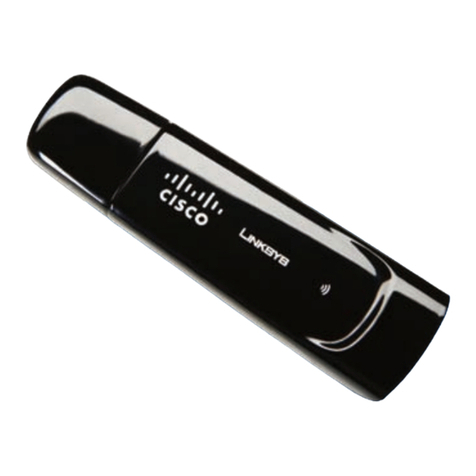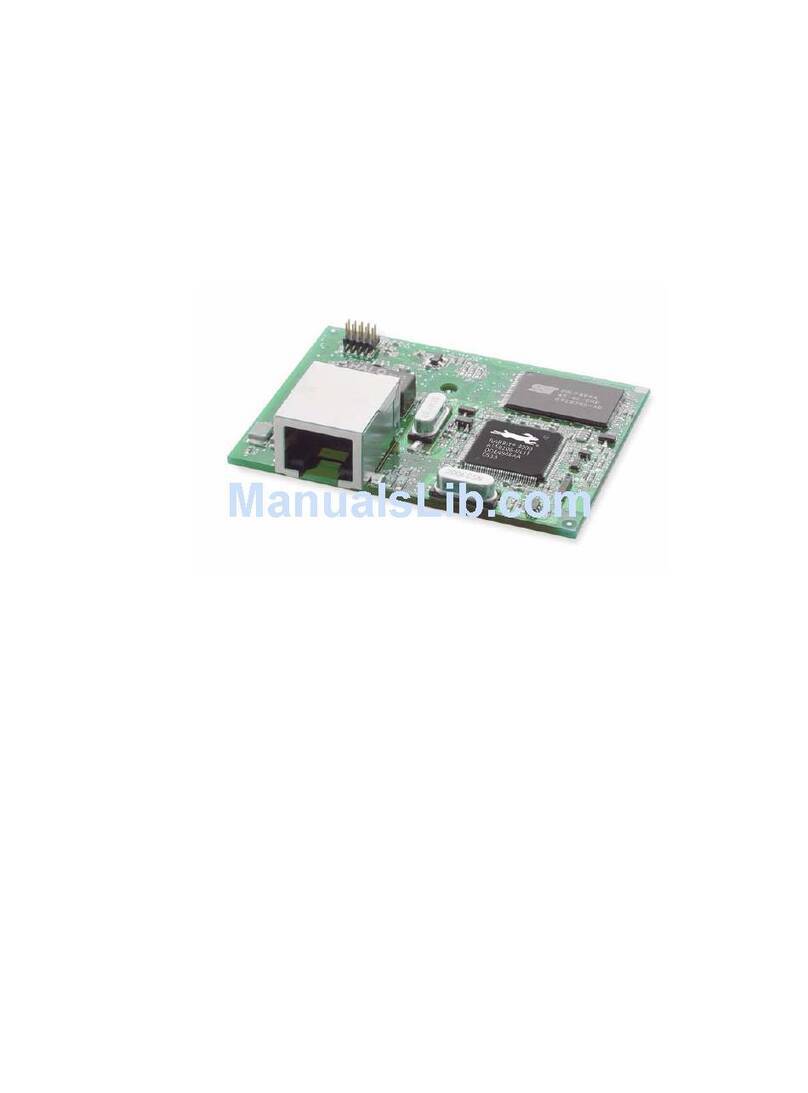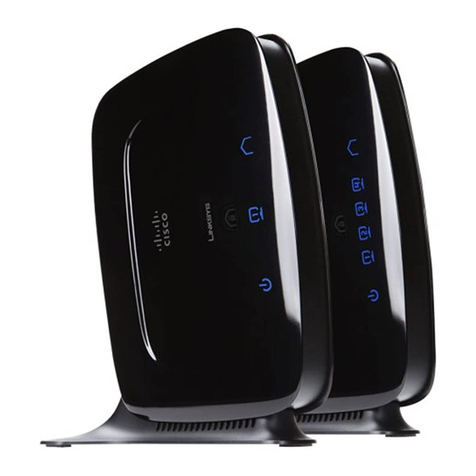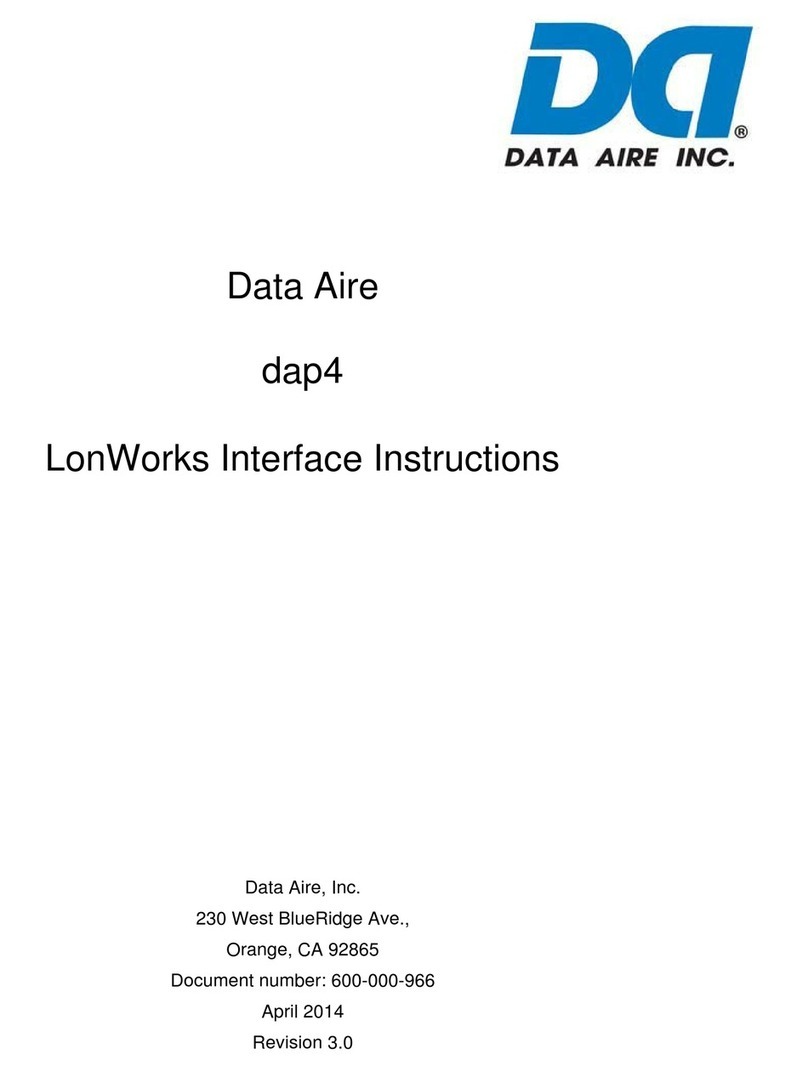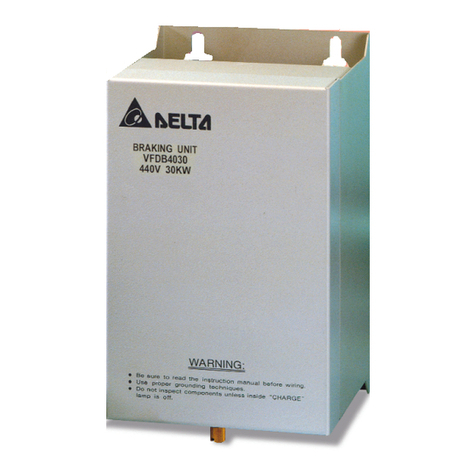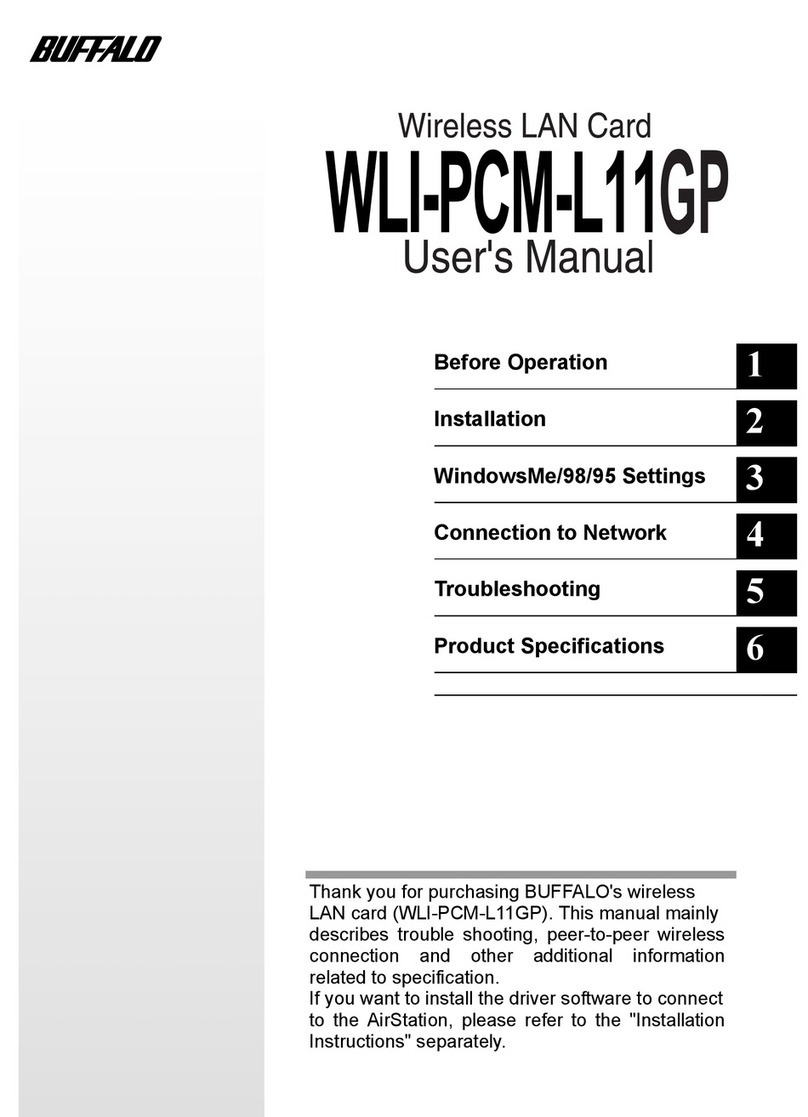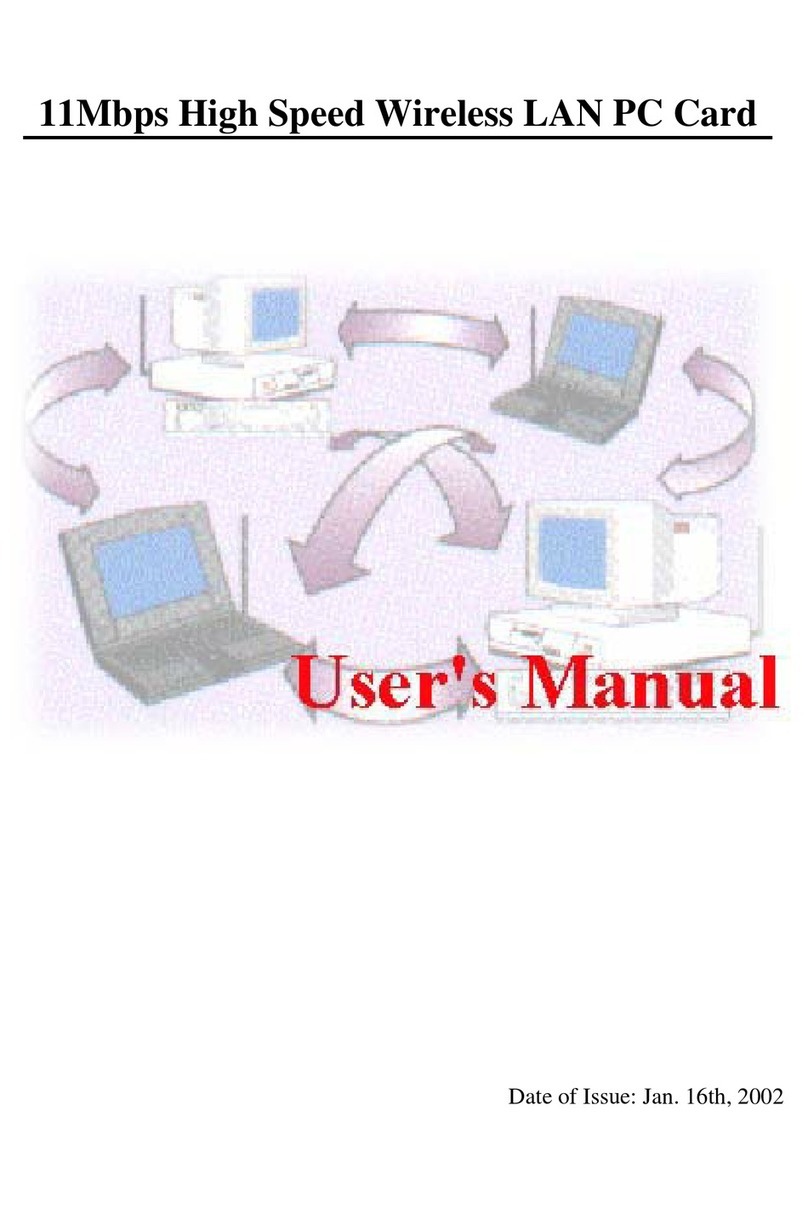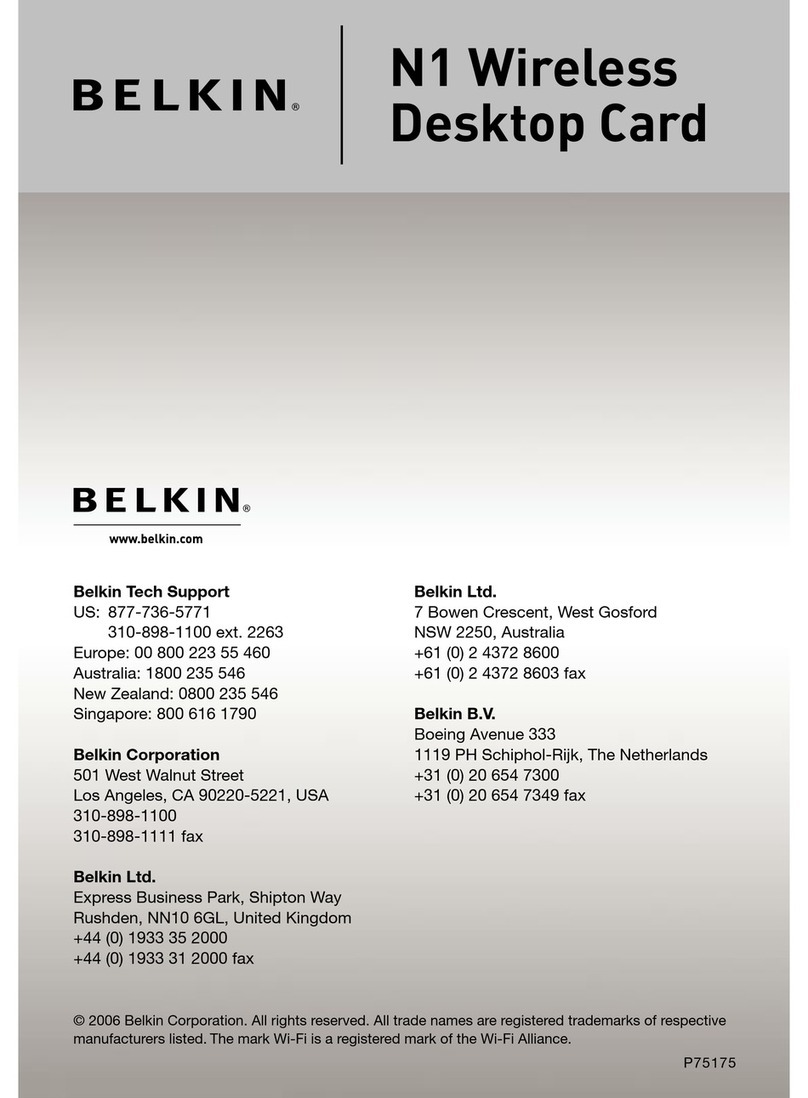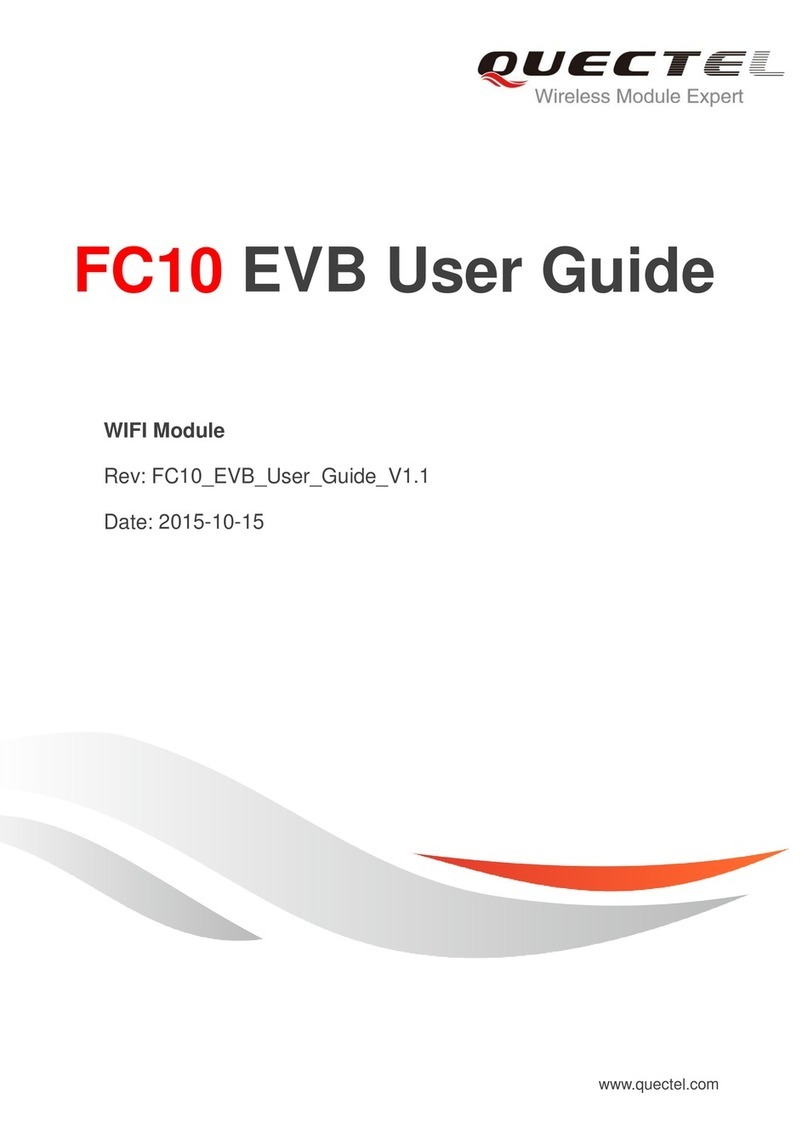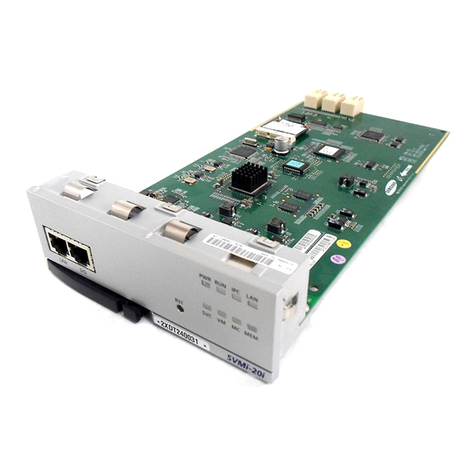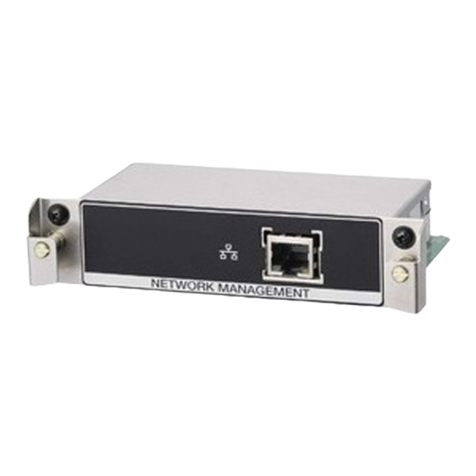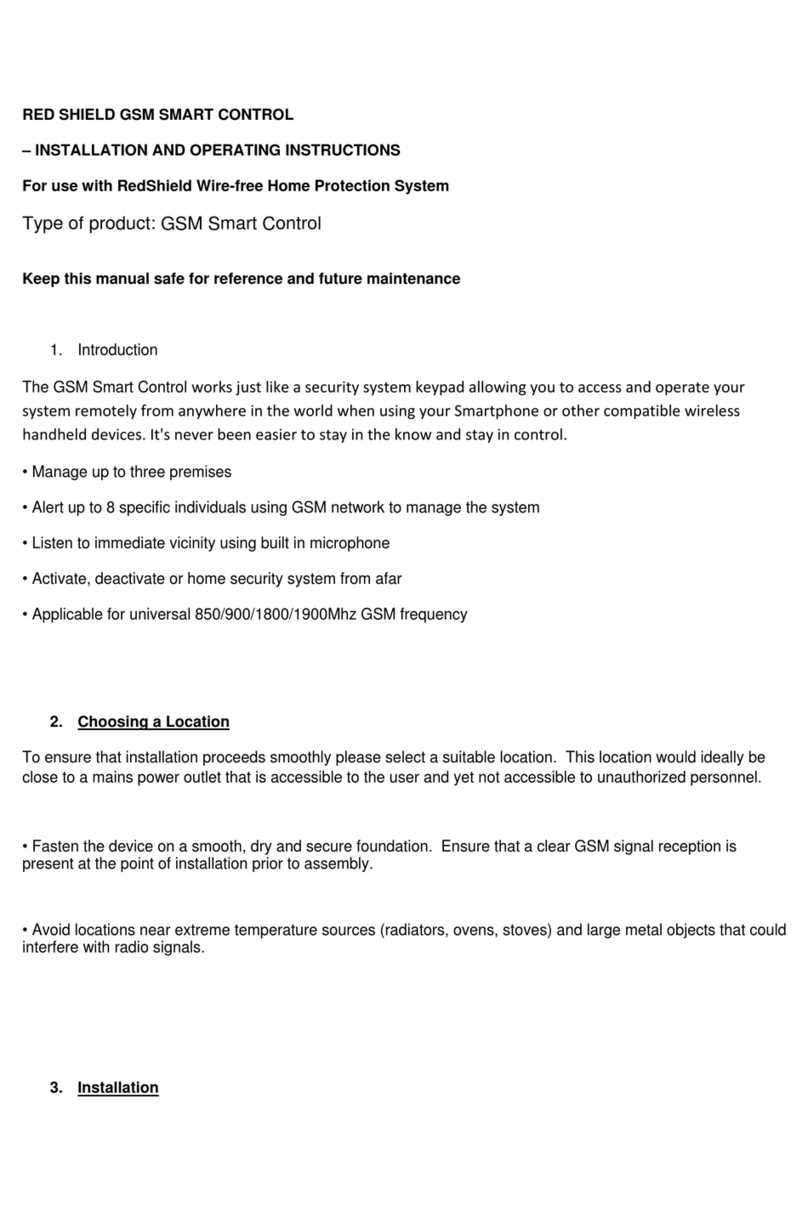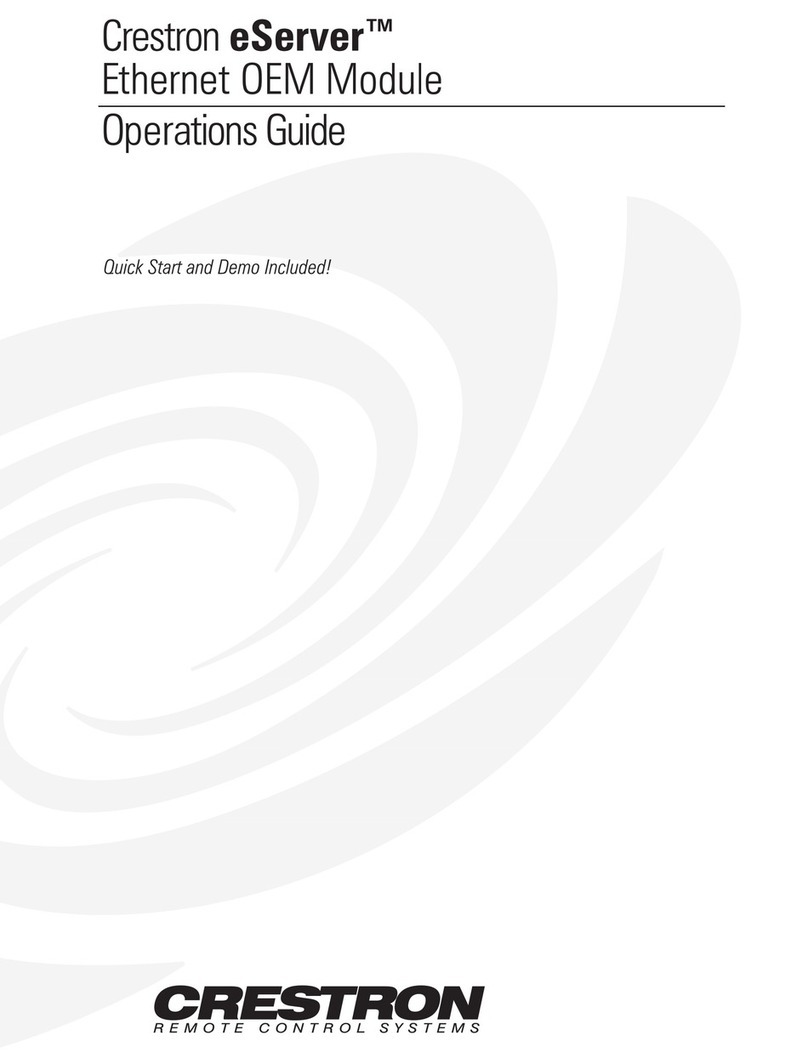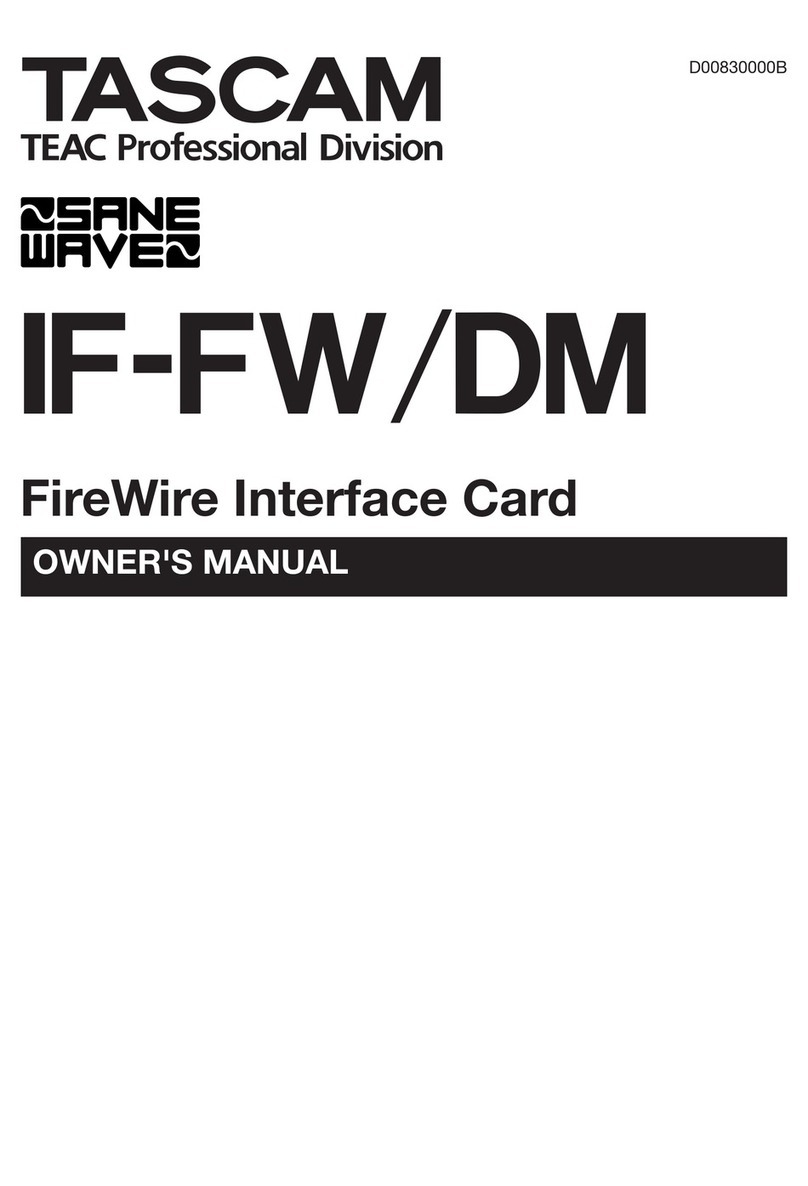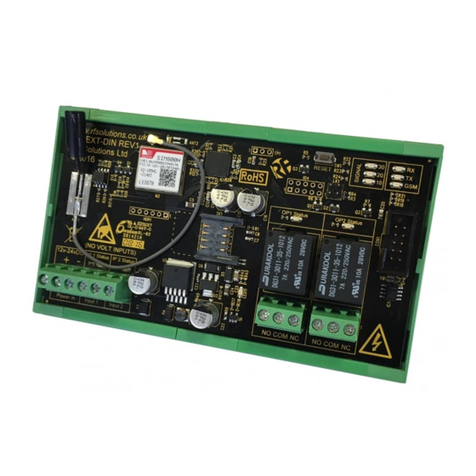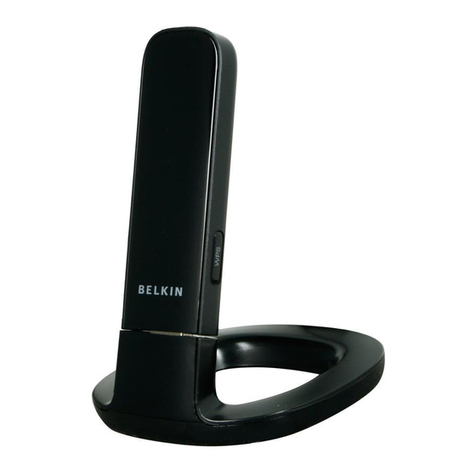General DataComm spectracomm ip User manual

6SHFWUD&RPP#,3#
ROUTER CARD
Installation & Operation Manual
076R200-000
Issue 2
October 2002

Copyright
©2002 General DataComm, Inc. ALL RIGHTS RESERVED.
This publication and the software it describes contain proprietary and confidential information. No part of this
document may becopied, photocopied, reproduced, translated or reduced to any electronic or machine-readable
format without prior written permission of General DataComm,Inc. The information in this document is subject
to change without notice. General DataComm assumes no responsibility for any damages arising from the use
of this document, including but not limited to, lost revenue, lost data, claims by third parties, or other damages.
If you have comments or suggestions concerning this manual, please contact:
General DataComm, Inc.
Technical Publications
6 Rubber Avenue
Naugatuck, Connecticut USA 06770
Telephone: 1 203 729 0271
Trademarks
All brand or product names are trademarks or registered trademarks of their respective companies or
organizations.
Documentation
Revision History - GDC P/N 076R200-000
Related Publications
-REV is the hardware revision (-000,-001, etc.)
-VREF is the most current software version (-V400 is Version 4.0.0.)
In addition to the publications listed above, always read Release Notes supplied with your products.
Issue Number Date Description of Change
1 April 2002 Initial Feature Set Documentation.
2 October 2002 Supports Spanning Tree Protocol.
Corrected and additional cable and pinout information.
Description Part Number
SpectraComm Shelf and Enclosure Installation and Operation Manual 010R302-REV
SpectraComm 2000 Shelf Installation and Operation Manual 010R358-REV
SC1001/1002 Enclosure Installation and Operation Manual 010R112-REV
SpectraComm Ethernet Switch Card Installation & Operation Manual 076R204-REV
Operation Manuals for individual SCM-compatible elements Refer to www.gdc.com for
specific element
Publications.
TEAM Operation Manuals for individual TEAM-managed elements

076R200-000 SpectraComm IP Router Card i
Issue 2 Installation and Operation Manual
Table of Contents
Preface
Precautions .........................................................................................................................vi
Compliance ............................................................................................................................. vii
Support Services and Training................................................................................................. ix
Corporate Client Services...................................................................................................ix
Factory Direct Support & Repair .......................................................................................ix
Contact Information ...........................................................................................................ix
Chapter 1: Introduction and Specifications
About this Document ............................................................................................................. 1-1
SpectraComm IP Overview ................................................................................................... 1-1
Features and Benefits .......................................................................................................1-2
CSU/DSU Functionality...................................................................................................1-3
Smart CLI.........................................................................................................................1-3
Web Management.............................................................................................................1-3
SC-IP Interfaces/Connectivity..........................................................................................1-3
SC-IP Router Applications...............................................................................................1-4
SC-IP LAN-X Applications .............................................................................................1-5
The SC-IP Front Panel........................................................................................................... 1-6
SC-IP Applications with Ethernet Switching...................................................................1-7
Technical Specifications........................................................................................................ 1-8
Chapter 2: Installation & Connections
Overview................................................................................................................................ 2-1
Unpacking Instructions.....................................................................................................2-2
SC-IP Equipment..............................................................................................................2-2
Shelf System Options.......................................................................................................2-2
Shelf and Card Connections................................................................................................... 2-4
Interface Port Descriptions...............................................................................................2-5
Interface Cables & Adapters ............................................................................................2-8
SC-IP Power-Up.............................................................................................................2-12
Chapter 3: SC-IP Configuration
SC-IP Configuration Overview.............................................................................................. 3-1
Command Line Interface (CLI) Basics ............................................................................3-1
Smart CLI Quick Reference.............................................................................................3-1
Initializing the SC-IP for Configuration ................................................................................ 3-2
Configuring SC-IP with Smart CLI....................................................................................... 3-3
Access to SC-IP Command Line Interface (CLI).............................................................3-3
Static Routing in a Frame Relay T1 Network..................................................................3-4

ii SpectraComm IP Router Card 076R200-000
Installation and Operation Manual Issue 2
Table of Contents
Static Routing in a Leased Line (PPP) T1 Network ........................................................ 3-7
LAN-Extension for T1 Flat Networks........................................................................... 3-10
Chapter 4: The Web Interface
Introduction to SC-IP Web Management.............................................................................. 4-1
Web Management Requirements..................................................................................... 4-1
Starting A Web Session................................................................................................... 4-2
SC-IP Web Screens ............................................................................................................... 4-3
Administration Web Screen............................................................................................. 4-4
Statistics Web Screen....................................................................................................... 4-5
Command Line Web Screen............................................................................................ 4-6
Interface Web Screen....................................................................................................... 4-7
IP Static Route Web Screen............................................................................................. 4-8
T1 Parameters Web Screen.............................................................................................. 4-9
Terminal Server Web Screen.........................................................................................4-10
DLCI Web Screen.......................................................................................................... 4-11
LMI Web Screen............................................................................................................4-12
Traffic Shaping ..............................................................................................................4-13
Appendix A:Application Guidelines
General Application Information.......................................................................................... A-1
Command Access Modes ..................................................................................................... A-1
SC-IP Default Configurations .............................................................................................. A-2
Using Sub-interfaces for Frame Relay PVCs....................................................................... A-3
IP Addresses......................................................................................................................... A-3
Establishing an IP Address ............................................................................................. A-5
Ones Density Enforcement................................................................................................... A-6
Batch Up/Download Overview ............................................................................................ A-7
Troubleshooting Communications Problems ....................................................................... A-8
Appendix B:CLI Reference
Using Smart CLI.................................................................................................................... B-1
CLI Command Tables ........................................................................................................... B-4
Command Overview........................................................................................................B-4
Clear Commands..............................................................................................................B-4
Configure Accounts Commands......................................................................................B-5
Configure Frame Relay Commands.................................................................................B-6
Configure Interfaces Commands .....................................................................................B-7
Configuration Tutorials ......................................................................................................... B-8
Example 1: Configuring SC-IP for IP Routing (Frame Relay)........................................B-8

076R200-000 SpectraComm IP Router Card iii
Issue 2 Installation and Operation Manual
Table of Contents
Example 2: Configuring SC-IP for IP Routing (PPP)...................................................B-12
Example 3: Configuring SC-IP for LAN-X Mode........................................................B-15

iv SpectraComm IP Router Card 076R200-000
Installation and Operation Manual Issue 2
Table of Contents

076R200-000 SpectraComm IP Router Card v
Issue 2 Installation and Operation Manual
Preface
Scope of this Manual
This manual describes installation and operation of the SpectraComm IP card (SC-IP). This
document is intended for network operators and installers and assumes a working knowledge of
data communication equipment.
The information in this manual has been carefully checked and is believed to be entirely reliable.
However, as General DataComm improves the reliability, function and design of its products, it is
possible that information may not be current. Check the General DataComm website at
http://www.gdc.com for updated product information or contact your General DataComm
field representative.
General DataComm, Inc.
6 Rubber Avenue
Naugatuck, Connecticut, USA 06770
Tel: 1 203 729-0271
Safety Information
This manual should be read in its entirety and all procedures completely understood before
installing or operating the unit. The notes that appear throughout this manual must be read prior to
any installation or operating procedure. Examples of notes used in this manual are shown below.
Note A note provides essential operating information not readily apparent which you should be
particularly aware of. A note is typically used as a suggestion.
Important Indicates an emphasized note. It is something you should be particularly aware of; something
not readily apparent. Important is typically used to prevent equipment damage.

Preface
vi SpectraComm IP Router Card 076R200-000
Installation and Operation Manual Issue 2
Precautions
The CAUTION, WARNING, and DANGER statements that appear throughout this manual are
intended to provide critical information for the safety of both the service engineer and operator,and
enhance equipment reliability. The definitions and symbols for such statements comply with ANSI
Z535.2, American National Standard for Environmental and Facility Safety Signs, and ANSI
Z535.4, Product Safety Signs and Labels, issued by the American National Standards Institute.
Safety Guidelines
Under proper conditions, this unit will operate reliably and safely in your network. If any
component is improperly handled or installed, equipment failure or personnel hazard may occur.
Use caution and common sense when installing network wires. Use the following guidelines,
especially when unsafe conditions exist or when potentially hazardous voltages are present:
• Repairs must be performed by qualified service personnel only.
• To reduce the risk of electrical shock, do not operate equipment with the cover removed.
• Never install network jacks in a wet location unless the jack is designed for that location.
• Never touch uninsulated network wires or terminals unless the network line is disconnected
at the network interface.
• Never install network wiring during an electrical storm.
Antistatic Precautions
Electrostatic discharge (ESD) results from the buildup of static electricity and can cause computer
components to fail. ESD occurs when a person whose body contains a static buildup touches a
computer component. The SC-IP card may contain static-sensitive devices that are easily damaged.
Proper handling, grounding and precautionary ESD measures are essential. Keep parts and cardsin
antistatic packaging during transport or when not in use. When handling always use antistatic
floorpads, workbenchpads and an antistatic wrist strap connected to a grounded equipment frame
or chassis. If a wrist strap is not available, periodically touch an unpainted metal surface on the
equipment. Never use a conductive tool, like a screw driver or paper clip to set switches.
CAUTION Indicates a potentially hazardous situation which, if not avoided, may result in
minor to moderate injury. It may also be used to alert against unsafe practices.
WARNING indicates an imminently hazardous situation which, if not avoided, could result
in death or serious injury.
DANGER indicates an imminently hazardous situation which, if not avoided, will result in
death or serious injury.

Preface Compliance
076R200-000 SpectraComm IP Router Card vii
Issue 2 Installation and Operation Manual
Compliance
FCC Part 68 Compliance
Connection of data communications equipment to the public telephone network is regulated by
FCC Rules and Regulations. This equipment complies with Part 68 of these regulations which
require all of the following:
For single or multi-line equipment that connects to the telephone network via a plug and jack, the
plug and jack must comply with the FCC Part 68 rules. This device is designed to be connected to
the telephone or premises wiring, using a compatible modular jack which is Part 68 compliant.
The telephone company may discontinue your service if the unit causes harm to the telephone
network. If possible, you will be notified of such an action in advance. If advance notice is not
practical,youwillbenotifiedassoonaspossibleand willbeadvisedofyourrighttofileacomplaint
with the FCC. The telephone company may change its communication facilities, equipment,
operations and procedures where reasonably required for operation. If so, the telephone company
will notify you in writing. All repairs or modifications to the equipment must be performed by
General DataComm. Any other repair or modification by a user voids the FCC registration and the
warranty.
To connect the product to the Public Telephone Network, you are required to give the following
information to the telephone company:
• FCC Registration Number: US:AG6DENAN97J
• Telephone Company jack type: RJ48C, RJ11C
• Facility Interface Codes: DDS - 04DU9-DN/BN/1KN/1SN, 02LS2
• Service Order Code: DDS- 6.0Y, 9.0Y
Industry Canada Notification
The Industry Canada label identifies certified equipment. This certification means that the
equipment meets telecommunications network protective, operation and safety requirements as
prescribed in the appropriate Terminal Equipment Technical Requirements document(s). The
Department does not guarantee the equipment will operate to the user's satisfaction.
Before installing this equipment, users should ensure that it is permissible to be connected to the
facilities of the local telecommunications company. The equipment must also be installed using an
acceptable method of connection. The customer should be aware that compliance with the above
conditions may not prevent degradation of service in some situations.
Repairsto certified equipment should be coordinatedby a representative designated by the supplier.
Any repairs or alterations made by the userto this equipment, or equipment malfunctions, may give
the telecommunications company cause to request the user to disconnect the equipment.
Users should ensure for their own protection that the electrical ground connections of the power
utility, telephone lines and internal metallic water pipe system, if present, are connected together.
This precaution may be particularly important in rural areas.
Caution: Users should not attempt to make such connections themselves, but should contact the
appropriate electric inspection authority, or electrician, as appropriate.

Preface Compliance
viii SpectraComm IP Router Card 076R200-000
Installation and Operation Manual Issue 2
Notice: The Ringer Equivalence Number (REN) assigned to each terminal device provides an
indication of the maximum number of terminals allowed to be connected to a telephone interface.
The termination on an interface may consist of any combination of devices subject only to the
requirement that the sum of the Ringer Equivalence Numbers of all the devices does not exceed 5.
Avis D’industrie Canada
L’étiquette d’Industrie Canada identifie le matériel homologué. Cette étiquette certifie que le
matériel est conforme aux normes de protection, d’exploitation et de sécurité des réseaux de
télécommunications, comme le prescrivent les documents concernant les exigences techniques
relatives au matériel terminal. Le Ministère n’assure toutefois pas que le matériel fonctionnera à la
satisfaction de l’utilisateur.
Avant d’installer ce matériel, l’utilisateur doit s’assurer qu’il est permis de le raccorder aux
installations de l’entreprise locale de télécommunication. Le matériel doit également être installé en
suivant une méthode acceptée de raccordement. L’abonné ne doit pas oublier qu’il est possible que
la comformité aux conditions énoncées ci-dessus n’empêche pas la dégradation du service dans
certaines situations.
Les réparations de matérielhomologué doivent être coordonnées par un représentant désignépar le
fournisseur. L’entreprise de télécommunications peut demander à l’utilisateur de débrancher un
appareil à la suite de réparations ou de modifications effectuées par l’utilisateur ou à cause de
mauvais fonctionnement.
Pour sa propre protection, l’utilisateur doit s’assurer que tous les fils de mise à la terre de la source
d’énergie électrique,deslignestéléphoniquesetdes canalisations d’eaumétalliques,s’ilyena, sont
raccordés ensemble. Cette précaution est particulièrement importante dans les régions rurales.
Avertissement: L’utilisateur ne doit pas tenter de faire ces raccordements lui-même; il doit avoir
recours à un service d’inspection des installations électriques, ou à un électricien, selon le cas.
Avis: L’indice d’équivalence de la sonnerie (IES) assigné à chaque dispositif terminal indique le
nombre maximal de terminaux qui peuvent être raccordés à une interface. La terminaison d’une
interface téléphonique peut consister en une combinaison de quelques dispositifs, à la seule
condition que la somme d’indices d’équivalence de la sonnerie de tous les dispositifs n’excède
pas 5.
Electromagnetic Compatibility
This Class A digital apparatus complies with FCC Part 15 and Canadian ICES-003.
La Compatibilité d’ Eléctro-magnetique
Cet appareil numerique de la classe A est conforme a la norme NMB-003 du Canada.
NEBS Compliance
Certified by independent labs for NEBS compliance to standards:
GR63 - Physical Protection
GR1089 - EMC and Safety

Preface Support Services and Training
076R200-000 SpectraComm IP Router Card ix
Issue 2 Installation and Operation Manual
Support Services and Training
GeneralDataCommofferstwocomprehensivecustomersupportorganizationsdedicatedtopre-and
post-sale support services and training for GDC products. Corporate Client Services and Factory-
Direct Support & Repair assist customers throughout the world in the installation, management,
maintenance and repair of GDC equipment. Located at GDC’s corporate facility in Naugatuck,
Connecticut USA, these customer support organizations work to ensure that customers get
maximum return on their investment through cost-effective and timely product support.
Corporate Client Services
Corporate Client Services is a technical support and services group that is available to GDC
customers throughout the world for network service and support of their GDC products. Customers
get thereliable support andtraining required for installation, management and maintenance of GDC
equipment in their global data communication networks. Training courses are available at GDC
corporate headquarters in Naugatuck, Connecticut, as well as at customer sites.
Factory Direct Support & Repair
GDC provides regularand warranty repair services through Factory Direct Support & Repair at its
U.S. headquarters in Naugatuck, Connecticut. This customer support organization repairs and
refurbishes GDC products, backed by the same engineering, documentation and support staff used
to build and test the original product. Every product received for repair at Factory Direct Support
& Repair is processed using the test fixtures and procedures specifically designed to confirm the
functionality of all features and configurations available in the product.
As part of GDC’s Factory Direct program, all product repairs incorporate the most recent changes
and enhancements from GDC Engineering departments, assuring optimal performance when the
customer puts the product back into service. Only GDC’s Factory Direct Support & Repair can
provide this added value.
Contact Information
General DataComm, Inc.
6 Rubber Avenue
Naugatuck, Connecticut 06770 USA
Attention: Corporate Client Services
Telephones: 1 800 523-1737
1 203 729-0271
Fax: 1 203 729-3013
Email: client[email protected]m
General DataComm, Inc.
6 Rubber Avenue
Naugatuck, Connecticut 06770 USA
Attention: Factory Direct Support & Repair
Telephones: 1 800 523-1737
1 203 729-0271
Fax: 1 203 729-7964
Email: factorydirect@gdc.com
Hours of Operation:
Monday - Friday 8:30 a.m. - 5:00 p.m. EST
(excluding holidays)
http://www.gdc.com

Preface Support Services and Training
x SpectraComm IP Router Card 076R200-000
Installation and Operation Manual Issue 2

076R200-000 SpectraComm IP Router Card 1-1
Issue 2 Installation and Operation Manual
Chapter 1: Introduction and
Specifications
About this Document
This document describes in detail the initial feature set for the SpectraComm IP
Router Card. Briefly mentioned are several additional features (DDS support and
modem facilities) which are planned for a future release. For more information on
the availability and operation of these additional features, refer to later issues of
this document or contact your GDC Sales Representative.
SpectraComm IP Overview
The SpectraComm IP (SC-IP) router card extends the carrier’s internal network to
remote locations where separate IP networks are required. SC-IP also functions as
a LAN-extension device which extends the carrier’s internal network to remote
locations where a single ‘flat’ IP network is required.
SpectraComm IP as Static IP Router
As a static IP router, SC-IP forwards IP data between serial WAN ports and an
Ethernet (LAN) switch. SC-IP’s eight-port terminal server can connect to craft
ports of co-located devices to provide out-of-band access.
Typically, the SC-IP provides connectivity via a T1 port. The link layer WAN
protocolssupportedareFrame Relay and thePoint-to-PointProtocol(PPP).Figure
1-1 shows SC-IP deployed in a Frame Relay, T1 network.
SC-IP as LAN-extension Device
When placed in LAN-extension mode, the SpectraComm IP extends the Carrier’s
local area network(s). Deployed inpairs, the SC-IPs are connected to their separate
LANs via the ethernet interface, and are connected to each other via the WAN.
GDC’s proprietary LAN-extension (LAN-X) is comprised of a link layer WAN
protocol (LAN-X) which requires a SC-IP configured for LAN-X at each end of
the WAN. Figure 1-2 shows SC-IP in multiple extensions to local and remote
LANs.
Typical Installations
The SC-IP is a rack-mount card that installs in a SC 5000 shelf (16 slots) or in a SC
2000 shelf (2 slots). For stand-alone, non-NEBS applications, the SC-IP card can
be installed in the SC 1001 or SC 1002 standalone enclosure.
SC-IP
INS ON
MODEM
T
XR
X
T1
AUX
TM ALM
C
R
A
F
T
P
O
R
T
1ETHERNET
12
P
O
R
T
2

Introduction and Specifications SpectraComm IP Overview
1-2 SpectraComm IP Router Card 076R200-000
Installation and Operation Manual Issue 2
Features and Benefits
• A low-cost, highly reliable and secure static router or LAN-extension device, in
NEBS-compliant packaging
• Uses ‘run from ram’ architecture for increased performance and configuration integrity.
• Front Panel LEDs indicate traffic, power and test status.
Front Panel LAN and Control (craft) ports provide connectivity.
• Shelf rear panel provides WAN connectivity for the SC-IP as router or LAN-X device.
• Provides access to T1 and Fractional T1 network services using an integral T1 CSU/DSU,
including long-haul (DS1) and short-haul (DSX-1) capability.
• Provides enhanced security with multi-level password protection.
• Provides scalable, high performance LAN via 10/100B-T ethernet switch support.
• Supports software upgrades via TFTP firmware download.
• Easily configured via the interactive “smart” command line interface or the intuitive, easy-to-
use web interface (HTTP).
• Can be monitored, configured and managed using standards-based protocols, includingTelnet,
SNMP and HTTP (web).
• Streamlined configuration of multiple SC-IPs via ASCII batch file upload/download.
• Provides quick access using Telnet “cut-thru” operation to terminal server ports.
• Provides integrated terminal server ports at the shelf rear panel connector for remote access of
up to eight devices.
• Allows standards-based IP application access (Telnet, SNMP or HTTP to remote equipment.
Supports ping on all interfaces.
• Uses Frame Relay or Point-to-Point Protocol (PPP) to provide link layer (Layer 2)
encapsulation of IP traffic.
• When pairs of SC-IPs are configured for LAN-extension mode, they provide link layer
encapsulation of ethernet frames for LAN extension between Carrier sites.
• Allows remote LAN-X configuration of a SC-IP via Remote Default Route configuration.
• Responds to HPOV polling and Auto Discovery.
• In LAN-X mode of operation, employs spanning tree protocol to block loops in the network
topology, preventing broadcast storms and similar undesireable network conditions.
Future SC-IP Upgrades
The following features are planned for a future release of the SC-IP. For more information on the
availability and operation of these additional features, refer to later issues of this document or
contact your GDC Sales Representative.
• When equipped with an integral modem or an attached modem, provides remote user access
for initial configuration of the SC-IP over a dial-up connection, eliminating “truck roll” costs.
• When equipped with the integral V.90 modem and with RADIUS enabled, provides additional
security for authentication of dial-up users.
• Supports major alarm reporting.
• Providesaccess to theDDS network using an integral synchronous DTE interface to an external
56/64Kbps DSU.

Introduction and Specifications SpectraComm IP Overview
076R200-000 SpectraComm IP Router Card 1-3
Issue 2 Installation and Operation Manual
CSU/DSU Functionality
The SC-IP contains an integrated CSU/DSU. Users can access digital services at T1/FT1 rates
through the network interface. The Network interface provides all N x 56/64 Kbps rates from
56kbps to 1.536 Mbps (where N=1 to 24) and supports both DS1 and DSX-1.
Smart CLI
The SC-IP employs an interactive command line interface that will feel familiar to most field
personnel. Added features include auto-prompting for command arguments, recognition of
abbreviated commands, online help, command line recall and an advanced utility for generating
downloadable ASCII configuration files.
Web Management
The SC-IP provides internet-ready network management (HTML and JAVA 1.1 support). An
embedded web server agent allows Read or Read-Write access to SC-IP using popular browsers.
SC-IP Interfaces/Connectivity
The typical installation environment for the SC-IP card is a SpectraComm 5000 or 2000 shelf.
SC-IP has multiple physical interfaces, described below. The unit is shipped from the factory with
all ports set to Disabled except for the Modem port and the AUX port.
Craft (Console) Port
The Craft port is used for local configuration and monitoring. This EIA-232 interface is fixed as
serial async 9600 baud, 8 data, 1 start/stop, no parity.
Ethernet (10/100BASE-T) LAN Ports
The two Ethernet (LAN) ports allows the SC-IP to connect directly to a computer’s LAN port, or
to a hub device or external ethernet switch for connection to many LAN devices. With the SC-ES
card co-located in the shelf, the SC-IP can access more equipment on LANs using 10BASE-T or
100BASE-T (twisted pair) wiring while maintaining NEBS compliance.
T1/FT1 (Network) Port
The SC-IP provides an integral, fully managed Full T1or Fractional T1 CSU/DSU with Frame
Relay UNI-U and PPP support.
Terminal Server Ports
Eight, 3-wire RS-232 ports connect up to eight devices (one port active at a time).
Future Upgrades
Asynchronous AUX/Synchronous DTE Port
This port is designed to accommodate two types of interfaces. The synchronous DTE (EIA-232)
interface can operate up to 64 kbps (max) and is used to connect directly to a SC 521A device for
DDS network connections (external timing is not supported.) The asynchronous AUX (EIA 232)
interface is used for connection to an external modem.
V.90/V.34 Modem Port
The modem port is designed to accept dial-up connections fordirect VT-100 access (Hyperterm) or
PPP session.
Note For configuration of SC-IP interfaces, refer to Chapter 2: Installation and Set-Up.

Introduction and Specifications SpectraComm IP Overview
1-4 SpectraComm IP Router Card 076R200-000
Installation and Operation Manual Issue 2
SC-IP Router Applications
The primary application of the SC-IP is in router mode, providing low-cost, NEBS-compliant IP
connectivity to the carrier’s internal network and between managed sites. NEBS-compliant SC-IP
can be located anywhere within a carrier’s network; for example SC-IP can be located within the
Central Office environment as part of the inside plant, or can be deployed in a remote office or
CEV-Hut environment as part of the outside plant.
Figure 1-1 shows a typical Network Operations Center managing its remote equipment via a
SC-IP at a remote site. With a SC-IP deployed in all remote offices, virtually all remote devices can
be connected back to the NOC through remote device ethernet (LAN) ports or their craft ports.
The SC-IP can be accessed from the NOC over the Carrier’s data network using multiple WAN
interfaces, such as its integral T1 CSU/DSU. In a future release, a synchronous DTE interface to an
external 56/64K DSU (SC521A) is supported.
The SC-IP in router mode exclusively uses static routes to ensure a greater degree of security and
reduce IP traffic in the carrier’s network. This requires the addition of static routes at the NOC and
the SC-IP.
Note The SC-IP’s LAN-X and IP forwarding functions are mutually exclusive; that is, when the SC-IP is used in
router applications, it cannot employ its LAN-X mode of operation.
Figure 1-1 Typical Deployment of SC-IP Router
DEVICE 2
DEVICE 1
DEVICE 8
.
.
.
LAN
NETWORK
MANAGER
ROUTER
MANAGEMENT
TERMINAL
MODEM
REMOTE OFFICE - Orlando
MANAGED
CRAFT DEVICES
Public
Switched
Telephone
Network
MIAMI NOC
REMOTE DIAL-IN USER
HOSTHOST
ETHERNET
MANAGED
LAN DEVICES
MODEM
TERMINAL
SERVER
SPECTRACOMM 2000
SC-IP
SC 2000 SHELF
T1
Data / Mgmt
Network
IP NETWORK "A" IP NETWORK "B"
Future Use

Introduction and Specifications SpectraComm IP Overview
076R200-000 SpectraComm IP Router Card 1-5
Issue 2 Installation and Operation Manual
SC-IP LAN-X Applications
A Network Operations Center (NOC) can extend its LANs via one or more pairs of SC-IPs. The
SC-IPs would be configured for LAN-X mode and connected back-to-back over the WAN. This
configuration provides a NEBS-compliant extension of a Carrier’s LAN so that any remote device
may be accessed from the NOC via the SC-IP.
For example, back-to-back SC-IPs can extend the LAN within a building (i.e., between floors) or,
more typically, across a WAN connection. Figure 1-2 shows a typical deployment of one pair of
SC-IP units in a carrier’s network. Multiple pairs of SC-IP units can be deployed to fan out the
NOC’s reach to additional remote sites.
SC-IP in LAN-X mode disables the unit’s IP routing function; thus, management of SC-IP is
conducted in one direction from a specified SC-IP port. While in LAN-X mode, a SC-IP port must
be specified for management.
SC-IP in LAN-X mode also supports spanning tree protocol to detect and eliminate loops and
provide data path redundancy in the in the network topology. If loops are detected, SC-IP in LAN-
X mode will block the paths that have the slowest link rate. Note that all bridges must be enabled
to derive the optimal benefit of spanning tree.
Note The SC-IP’s LAN-X and IP forwarding functions are mutually exclusive; that is, when the SC-IP is placed in
LAN-extension mode, the IP routing functions are not available.
Note IMPORTANT: It is the responsibility of the network planner to ensure that when SC-IP is in LAN-X mode, a
loop condition must not be in effect.
Figure 1-2 Typical Deployment of SC-IP in LAN-extension Mode
HOST
HOSTHOST
LAN
NETWORK
MANAGER
REMOTE OFFICE: IP NETWORK "A"
NOC: IP NETWORK "A"
T1
HOST
HOSTHOST
LAN
ETHERNET
DEVICE 2
DEVICE 1
DEVICE 8
.
.
.
MANAGED
CRAFT DEVICES
SPECTRACOMM 2000
SC-IP
ETHERNET
LAN SEGMENT "X" LAN SEGMENT "Y"
SPECTRACOMM 2000
SC-IP
T1 TERMINAL
SERVER

Introduction and Specifications The SC-IP Front Panel
1-6 SpectraComm IP Router Card 076R200-000
Installation and Operation Manual Issue 2
The SC-IP Front Panel
Table 1-1 describes the front panel connectors and indicators on the SC-IP Router card.
Figure 2-1 describes the SC-IP rearpanel asdeployed in a SpectraCommshelf or enclosure system.
Physical features that support DDS and Modem facilities are implemented in a future release.
Table 1-1 SC-IP Card Front Panel
SC-IP Front Panel LEDs / Ports Description Action
ON On (GREEN) indicates SC-IP is receiving power.
INS On (GREEN) indicates SC-IP is ready for operation.
MODEM TX
-Future Use-
Off No send data present at the Modem port.
On (GREEN) Indicates Send Data frames are present at the Modem port.
MODEM RX
-Future Use-
Off No Receive Data present at the Modem port.
On (GREEN) Indicates the presence of data frames at the Modem port,
received from the remote modem.
T1 TX Off No data is being sent out at T1 Network port.
On (GREEN) Indicates Send Data frames are present at the T1 Network
port.
T1 RX Off No Receive Data present at the T1 Network port.
On (GREEN) Indicates data present at the T1 port, originating from the
Network.
AUX TX
-Future Use-
Off No send data present at the AUX port.
On (GREEN) Indicates Send Data frames are present at the AUX port.
AUX RX
-Future Use-
Off No Receive Data present at the AUX port.
On (GREEN) Indicates Receive Data frames present at the AUX port.
ALM
-Future Use-
Off Normal conditions.
On (RED) Indicates T1 Network alarm (AIS, RAI, or LAD).
TM
-Future Use-
Off Indicates normal operating conditions.
On (RED) Indicates SC-IP is in Test Mode, performing a diagnostic test.
Craft Port RS-561-compatible jack for direct connection of the unit to a local
VT100-compatible ASCII terminal.
Ethernet Port 1 Each Ethernet port supports
10/100Base-T connectivity.
Ethernet Port 2
Ethernet LEDs
(1 and 2) Off Ethernet port 1 or 2 is not connected
On (STEADY) Steady On (GREEN) indicates the Ethernet port (1 or 2) is
connected and not passing data.
ON (BLINKING) Blinking On (GREEN) indicates the Ethernet port (1 or 2) is
connected and actively passing data.
SC-IP E1
INS ON
MODEM
T
XR
X
E1
AUX
TM ALM
C
R
A
F
T
P
O
R
T
1ETHERNET
12
P
O
R
T
2

Introduction and Specifications The SC-IP Front Panel
076R200-000 SpectraComm IP Router Card 1-7
Issue 2 Installation and Operation Manual
SC-IP Applications with Ethernet Switching
The SpectraComm Ethernet Switches (SC-ES 9-Port or SC-ES 18-Port switch) are designed for use
in the Carrier's internal management network and complements the SC-IP’s router and LAN-X
operations. A SpectraComm Ethernet Switch card extends NEBS-compliant, switched Ethernet
connectivity to the Carrier's remote sites.
SpectraComm Ethernet switch provides the following benefits in a SC-IP application:
• Eases network congestion on existing shared-hub network traffic by breaking up the collision
domain, thereby dramatically increasing network performance.
• Eliminates unnecessary network traffic by delivering dedicated bandwidth for each port. LAN
equipment at the remote site can be connected to the SC-ES using 10/100Base-T LAN
connections.
• Provides port statistics and configuration features that are usually associated only with high-
end, fully managed switches.
• Can operate stand-alone or cascaded with more SC-ES cards to satisfy the port density
requirements for your network applications.
Figure 1-3 Deployment of SC-IP and SC-ES
LAN DEVICE 2
LAN DEVICE 1
SPECTRACOMM 2000
SC-ESSC-IP
SC 2000 SHELF
CRAFT DEVICE 2
CRAFT DEVICE 1
CRAFT DEVICE 8
.
.
.
LAN
NETWORK
MANAGER
ROUTER
MANAGEMENT
TERMINAL
MODEM
REMOTE OFFICE
T1
Data / Mgmt
Network
Public
Switched
Telephone
Network
NOC
REMOTE DIAL-IN USER
LAN
LAN DEVICE 8
.
.
.

Introduction and Specifications Technical Specifications
1-8 SpectraComm IP Router Card 076R200-000
Installation and Operation Manual Issue 2
Technical Specifications
The following table describes the physical, operational, and environmental specifications for the
SpectraComm IP. Conforming to these specifications ensures maximum system performance and
reduces the chances of mechanical breakdown and personnel hazard.
Table 1-2 SC-IP Specifications (Initial Feature Set)
Item Specification Description
Physical
Characteristics Dimensions W: 178 mm (7.0 in.); H: 21 mm (0.81 in.); D: 241 mm (9.5 in.)
Weight Weight: 0.28 kg (10 oz.; Shipping weight: 0.74 kg (1 lb 10 oz)
Electrical
Characteristics Power Requirements AC or DC power, according to your SpectraComm shelf
configuration.
Voltage/Frequency Refer to the appropriate SpectraComm Shelf Manual.
Fusing Refer to the appropriate SpectraComm Shelf Manual.
Power Dissipation 6 Watts maximum, each
Environment Non-operating Temperature: -40 to 70 degrees C (-40 to 158 degrees F)
Relative humidity: 5% to 95%
Altitude: Up to 12,191 m (40,000 ft)
Operating Temperature: 0 to 50 degrees C (32 to 122 degrees F)
Relative humidity: 5% - 90%, non-condensing
Altitude: -60 to 4,000 m (-197 to 13,123 ft)
For altitudes above 1800 m (5906 ft), derate by
one degree C per 300 m (1 degree C per 1000 ft).
Integral CSU/
DSU Communication Line T1 digital carrier (non-loaded, staggered-twist ABAM, PIC or
pulp-insulated exchange-type cable (19-26 gauge)
Line Impedance 100 Ohm
Network (T1) DS1 or DSX-1, RJ48C modular jack
Frequency 1,544,000 bps +/-75 bps
Line Buildout 0.0, 7.5, or 15 dB (selectable or automatic) at 772 kHz
Timing Source Internal clock, slave (receive timing loopback)
Pulse Density 8 (n+1)
Data Rate N x 56/64 Kbps, where N = 1 - 24 DS0s
Data Encoding AMI (at 56 x N Kbps) or B8ZS (at 56/64 x N Kbps)
Frame Format/Mode D4, AT&T TR-54016 ESF, ANSI T1.403 ESF
Management Command Line Interface Terminal and Telnet command line interface (CLI)
HTTP Interface Web pages and web-based CLI via embedded web-server
agent via PC browser (HTML and JAVA 1.1 supported)
SNMP Management SNMP support for standard statistics.
Inband Management In one direction from NOC SC-IP towards remote site
(LAN-X mode only)
Terminal Server
Interface DTE Speeds Asynchronous 2400, 9600, 19200, 38400, 57600 (RS232)
This manual suits for next models
1
Table of contents
